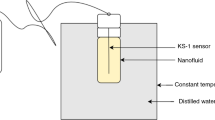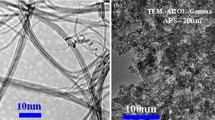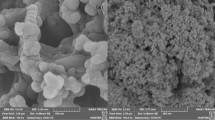Abstract
In this study two appropriate semi-experimental models based on none-linear regression over 800 extracted experimental data to predict the thermal conductivity coefficient of nanofluids were presented. Here, the used nanofluids were spherical nanoparticles of Al2O3, TiO2, CuO, ZnO, ZrO2, CeO2, MgO, SiO2, Fe2O3, Fe3O4, Al, Cu, Fe, Ag, SiC and diamond dispersed in water, ethylene glycol, radiator coolant and various oils as base fluids. The thermal conductivity coefficient of particles and base fluid, temperature in the range of 10–80 °C, volume fraction from 0.04% to 14% were considered as effective parameters to develop first model (model 4-P), whereas, the second model were presented by taking the effect of particle diameter from 4 to150 nm into account (model 5-P). The mean square error and correlation coefficient were found to be 0.00059 and 0.9939 for 4-P model, and 0.000548 and 0.9944 for 5-P model, respectively, for all data. The highest error of the predicted value using model 5-P based on water, oil and ethylene glycols fluids were obtained 9.5, 3.9 and 3.5%, respectively, indicating proper accuracy of this model. Our proposed model was also validate using 104 experimental point. The results exhibited a low error value less than 2.1% and 5% for oil and water-based nanofluids, respectively. Hence the proposed model 5-P can be considered as an efficient model to predict the thermal conductivity coefficient of nanofluids.



Similar content being viewed by others
Abbreviations
- Cu:
-
Copper
- Ag:
-
Silver
- Al2O3 :
-
Aluminum oxide
- CuO:
-
Copper oxides
- SiC:
-
Silicon carbide
- CNT:
-
Carbon nanotubes
- EG:
-
Ethylene glycol
- EO:
-
Engine oil
References
Okonkwo EC, Wole-Osho I, Almanassra IW et al (2020) An updated review of nanofluids in various heat transfer devices. Springer International Publishing
Gupta SK, Gupta S, Gupta T et al (2020) A review on recent advances and applications of nanofluids in plate heat exchanger. Mater. Today Proc
Huminic G, Huminic A (2012) Application of nanofluids in heat exchangers: A review. Renew Sustain Energy Rev 16:5625–5638. https://doi.org/10.1016/j.rser.2012.05.023
Vanaki SM, Ganesan P, Mohammed HA (2016) Numerical study of convective heat transfer of nanofluids: A review. Renew Sustain Energy Rev 54:1212–1239. https://doi.org/10.1016/j.rser.2015.10.042
Hajatzadeh Pordanjani A, Aghakhani S, Afrand M et al (2019) An updated review on application of nanofluids in heat exchangers for saving energy. Energy Convers Manag 198:111886. https://doi.org/10.1016/j.enconman.2019.111886
Selvam C, Solaimalai Raja R, Mohan Lal D, Harish S (2017) Overall heat transfer coefficient improvement of an automobile radiator with graphene based suspensions. Int J Heat Mass Transf 115:580–588. https://doi.org/10.1016/j.ijheatmasstransfer.2017.08.071
Paul G, Chopkar M, Manna I, Das PK (2010) Techniques for measuring the thermal conductivity of nanofluids: A review. Renew Sustain Energy Rev 14:1913–1924. https://doi.org/10.1016/j.rser.2010.03.017
Mehta S, Chauhan KP, Kanagaraj S (2011) Modeling of thermal conductivity of nanofluids by modifying Maxwell’s equation using cell model approach. J Nanoparticle Res 13:2791–2798. https://doi.org/10.1007/s11051-010-0167-0
Yang L, Xu J, Du K, Zhang X (2017) Recent developments on viscosity and thermal conductivity of nanofluids. Powder Technol 317:348–369. https://doi.org/10.1016/j.powtec.2017.04.061
Ambreen T, Kim MH (2020) Influence of particle size on the effective thermal conductivity of nanofluids: A critical review. Appl Energy 264.https://doi.org/10.1016/j.apenergy.2020.114684
Kazemi-Beydokhti A, Heris SZ, Moghadam N et al (2014) Experimental Investigation of Parameters Affecting Nanofluid Effective Thermal Conductivity. Chem Eng Commun 201:593–611. https://doi.org/10.1080/00986445.2013.782291
Kim SH, Choi SR, Kim D (2007) Thermal conductivity of metal-oxide nanofluids: Particle size dependence and effect of laser irradiation. J Heat Transfer 129:298–307. https://doi.org/10.1115/1.2427071
Wen D, Lin G, Vafaei S, Zhang K (2009) Review of nanofluids for heat transfer applications. Particuology 7:141–150. https://doi.org/10.1016/j.partic.2009.01.007
Zhang Y, Xu X (2020) Predicting the thermal conductivity enhancement of nanofluids using computational intelligence. Phys Lett Sect A Gen At Solid State Phys 384:126500. https://doi.org/10.1016/j.physleta.2020.126500
Moghadam IP, Afrand M, Hamad SM et al (2020) Curve-fitting on experimental data for predicting the thermal-conductivity of a new generated hybrid nanofluid of graphene oxide-titanium oxide/water. Phys A Stat Mech its Appl 548:122140. https://doi.org/10.1016/j.physa.2019.122140
Ramezanizadeh M, Alhuyi Nazari M, Ahmadi MH et al (2019) A review on the applications of intelligence methods in predicting thermal conductivity of nanofluids. J Therm Anal Calorim 138:827–843. https://doi.org/10.1007/s10973-019-08154-3
Yang L, Xu X, Jiang W, Du K (2017) A new thermal conductivity model for nanorod-based nanofluids. Appl Therm Eng 114:287–299. https://doi.org/10.1016/j.applthermaleng.2016.11.183
Briclot A, Henry JF, Popa C et al (2020) Experimental investigation of the heat and fluid flow of an Al2O3-water nanofluid in the laminar-turbulent transition region. Int J Therm Sci 158:106546. https://doi.org/10.1016/j.ijthermalsci.2020.106546
Lee S, Choi S, Li S, Eastman J (2013) Measuring Thermal Conductivity of Fluids Containing Oxide Nanoparticles. Heat Transf 121:280–289
Yu W, **e H, Li Y et al (2011) Experimental investigation on the thermal transport properties of ethylene glycol based nanofluids containing low volume concentration diamond nanoparticles. Colloids Surfaces A Physicochem Eng Asp 380:1–5. https://doi.org/10.1016/j.colsurfa.2010.11.020
Murshed SMS, Leong KC, Yang C (2008) Investigations of thermal conductivity and viscosity of nanofluids. Int J Therm Sci 47:560–568. https://doi.org/10.1016/j.ijthermalsci.2007.05.004
Chon CH, Kihm KD, Lee SP, Choi SUS (2005) Empirical correlation finding the role of temperature and particle size for nanofluid (Al 2O 3) thermal conductivity enhancement. Appl Phys Lett 87:1–3. https://doi.org/10.1063/1.2093936
Das SK, Putra N, Thiesen P, Roetzel W (2003) Temperature dependence of thermal conductivity enhancement for nanofluids. J Heat Transfer 125:567–574. https://doi.org/10.1115/1.1571080
Mintsa HA, Roy G, Nguyen CT, Doucet D (2009) New temperature dependent thermal conductivity data for water-based nanofluids. Int J Therm Sci 48:363–371. https://doi.org/10.1016/j.ijthermalsci.2008.03.009
Elias MM, Mahbubul IM, Saidur R et al (2014) Experimental investigation on the thermo-physical properties of Al2O3 nanoparticles suspended in car radiator coolant. Int Commun Heat Mass Transf 54:48–53. https://doi.org/10.1016/j.icheatmasstransfer.2014.03.005
Esfe MH, Saedodin S (2014) Experimental investigation and proposed correlations for temperaturedependent thermal conductivity enhancement of ethylene glycol based nanofluid containing ZnO nanoparticles. J Heat Mass Transf Res 1:47–54. https://doi.org/10.22075/jhmtr.2014.153
Peñas JRV, Ortiz De Zárate JM, Khayet M (2008) Measurement of the thermal conductivity of nanofluids by the multicurrent hot-wire method. J Appl Phys 104.https://doi.org/10.1063/1.2970086
Yu W, **e H, Chen L, Li Y (2009) Investigation of thermal conductivity and viscosity of ethylene glycol based ZnO nanofluid. Thermochim Acta 491:92–96. https://doi.org/10.1016/j.tca.2009.03.007
Said Z, Saidur R, Hepbasli A, Rahim NA (2014) New thermophysical properties of water based TiO2 nanofluid-The hysteresis phenomenon revisited. Int Commun Heat Mass Transf 58:85–95. https://doi.org/10.1016/j.icheatmasstransfer.2014.08.034
Duangthongsuk W, Wongwises S (2009) Measurement of temperature-dependent thermal conductivity and viscosity of TiO2-water nanofluids. Exp Therm Fluid Sci 33:706–714. https://doi.org/10.1016/j.expthermflusci.2009.01.005
Patel HE, Sundararajan T, Das SK (2010) An experimental investigation into the thermal conductivity enhancement in oxide and metallic nanofluids. J Nanoparticle Res 12:1015–1031. https://doi.org/10.1007/s11051-009-9658-2
Hong TK, Yang HS, Choi CJ (2005) Study of the enhanced thermal conductivity of Fe nanofluids. J Appl Phys 97.https://doi.org/10.1063/1.1861145
Sundar LS, Hortiguela MJ, Singh MK, Sousa ACM (2016) Thermal conductivity and viscosity of water based nanodiamond (ND) nanofluids: An experimental study. Int Commun Heat Mass Transf 76:245–255. https://doi.org/10.1016/j.icheatmasstransfer.2016.05.025
Yeganeh M, Shahtahmasebi N, Kompany A et al (2010) Volume fraction and temperature variations of the effective thermal conductivity of nanodiamond fluids in deionized water. Int J Heat Mass Transf 53:3186–3192. https://doi.org/10.1016/j.ijheatmasstransfer.2010.03.008
Hemmat Esfe M, Saedodin S, Mahmoodi M (2014) Experimental studies on the convective heat transfer performance and thermophysical properties of MgO-water nanofluid under turbulent flow. Exp Therm Fluid Sci 52:68–78. https://doi.org/10.1016/j.expthermflusci.2013.08.023
Madhesh D, Kalaiselvam S (2014) Experimental study on the heat transfer and flow properties of Ag–ethylene glycol nanofluid as a coolant. Heat Mass Transf und Stoffuebertragung 50:1597–1607. https://doi.org/10.1007/s00231-014-1370-9
Karimi A, Goharkhah M, Ashjaee M, Shafii MB (2015) Thermal Conductivity of Fe2O3 and Fe3O4 Magnetic Nanofluids Under the Influence of Magnetic Field. Int J Thermophys 36:2720–2739. https://doi.org/10.1007/s10765-015-1977-1
Timofeeva EV, Moravek MR, Singh D (2011) Improving the heat transfer efficiency of synthetic oil with silica nanoparticles. J Colloid Interface Sci 364:71–79. https://doi.org/10.1016/j.jcis.2011.08.004
Singh D, Timofeeva EV, Moravek MR et al (2014) Use of metallic nanoparticles to improve the thermophysical properties of organic heat transfer fluids used in concentrated solar power. Sol Energy 105:468–478. https://doi.org/10.1016/j.solener.2014.02.036
Abareshi M, Goharshadi EK, Mojtaba Zebarjad S et al (2010) Fabrication, characterization and measurement of thermal conductivity of Fe3O4 nanofluids. J Magn Magn Mater 322:3895–3901. https://doi.org/10.1016/j.jmmm.2010.08.016
Zhang X, Gu H, Fujii M (2006) Experimental study on the effective thermal conductivity and thermal diffusivity of nanofluids. Int J Thermophys 27:569–580. https://doi.org/10.1007/s10765-006-0054-1
Khdher AM, Sidik NAC, Hamzah WAW, Mamat R (2016) An experimental determination of thermal conductivity and electrical conductivity of bio glycol based Al2O3 nanofluids and development of new correlation. Int Commun Heat Mass Transf 73:75–83. https://doi.org/10.1016/j.icheatmasstransfer.2016.02.006
Alirezaie A, Hajmohammad MH, Hassani Ahangar MR, Hemmat Esfe M (2018) Price-performance evaluation of thermal conductivity enhancement of nanofluids with different particle sizes. Appl Therm Eng 128:373–380. https://doi.org/10.1016/j.applthermaleng.2017.08.143
Kumar V, Tiwari AK, Ghosh SK (2017) Characterization and performance of nanofluids in plate heat exchanger. Mater Today Proc 4:4070–4078. https://doi.org/10.1016/j.matpr.2017.02.310
Tiwari AK, Ghosh P, Sarkar J (2013) Performance comparison of the plate heat exchanger using different nanofluids. Exp Therm Fluid Sci 49:141–151. https://doi.org/10.1016/j.expthermflusci.2013.04.012
Pryazhnikov MI, Minakov AV, Rudyak VY, Guzei DV (2017) Thermal conductivity measurements of nanofluids. Int J Heat Mass Transf 104:1275–1282. https://doi.org/10.1016/j.ijheatmasstransfer.2016.09.080
Sharafeldin MA, Gróf G (2018) Experimental investigation of flat plate solar collector using CeO2-water nanofluid. Energy Convers Manag 155:32–41. https://doi.org/10.1016/j.enconman.2017.10.070
Li X, Zou C, Lei X, Li W (2015) Stability and enhanced thermal conductivity of ethylene glycol-based SiC nanofluids. Int J Heat Mass Transf 89:613–619. https://doi.org/10.1016/j.ijheatmasstransfer.2015.05.096
Alawi OA, Sidik NAC, **an HW et al (2018) Thermal conductivity and viscosity models of metallic oxides nanofluids. Int J Heat Mass Transf 116:1314–1325. https://doi.org/10.1016/j.ijheatmasstransfer.2017.09.133
Chen W, Zou C, Li X, Li L (2017) Experimental investigation of SiC nanofluids for solar distillation system: Stability, optical properties and thermal conductivity with saline water-based fluid. Int J Heat Mass Transf 107:264–270. https://doi.org/10.1016/j.ijheatmasstransfer.2016.11.048
Bhanushali S, Jason NN, Ghosh P et al (2017) Enhanced Thermal Conductivity of Copper Nanofluids: The Effect of Filler Geometry. ACS Appl Mater Interfaces 9:18925–18935. https://doi.org/10.1021/acsami.7b03339
Shima PD, Philip J, Raj B (2010) Synthesis of aqueous and nonaqueous iron oxide nanofluids and study of temperature dependence on thermal conductivity and viscosity. J Phys Chem C 114:18825–18833. https://doi.org/10.1021/jp107447q
Kole M, Dey TK (2013) Enhanced thermophysical properties of copper nanoparticles dispersed in gear oil. Appl Therm Eng 56:45–53. https://doi.org/10.1016/j.applthermaleng.2013.03.022
Parekh K, Lee HS (2010) Magnetic field induced enhancement in thermal conductivity of magnetite nanofluid. J Appl Phys 107:7–10. https://doi.org/10.1063/1.3348387
Jeong J, Li C, Kwon Y et al (2013) Particle shape effect on the viscosity and thermal conductivity of ZnO nanofluids. Int J Refrig 36:2233–2241. https://doi.org/10.1016/j.ijrefrig.2013.07.024
Ghanbarpour M, Bitaraf Haghigi E, Khodabandeh R (2014) Thermal properties and rheological behavior of water based Al2O3 nanofluid as a heat transfer fluid. Exp Therm Fluid Sci 53:227–235. https://doi.org/10.1016/j.expthermflusci.2013.12.013
Hemmat Esfe M, Saedodin S, Wongwises S, Toghraie D (2015) An experimental study on the effect of diameter on thermal conductivity and dynamic viscosity of Fe/water nanofluids. J Therm Anal Calorim 119:1817–1824. https://doi.org/10.1007/s10973-014-4328-8
Beck MP, Yuan Y, Warrier P, Teja AS (2009) The effect of particle size on the thermal conductivity of alumina nanofluids. J Nanoparticle Res 11:1129–1136. https://doi.org/10.1007/s11051-008-9500-2
Li H, Wang L, He Y et al (2014) Experimental investigation of thermal conductivity and viscosity of ethylene glycol based ZnO nanofluids. Appl Therm Eng 88:363–368. https://doi.org/10.1016/j.applthermaleng.2014.10.071
Aberoumand S, Jafarimoghaddam A, Moravej M et al (2016) Experimental study on the rheological behavior of silver-heat transfer oil nanofluid and suggesting two empirical based correlations for thermal conductivity and viscosity of oil based nanofluids. Appl Therm Eng 101:362–372. https://doi.org/10.1016/j.applthermaleng.2016.01.148
Hassani S, Saidur R, Mekhilef S, Hepbasli A (2015) A new correlation for predicting the thermal conductivity of nanofluids; using dimensional analysis. Int J Heat Mass Transf 90:121–130. https://doi.org/10.1016/j.ijheatmasstransfer.2015.06.040
Author information
Authors and Affiliations
Corresponding author
Ethics declarations
Conflict of interest
The authors declare that they have no conflict of interest.
Additional information
Publisher's Note
Springer Nature remains neutral with regard to jurisdictional claims in published maps and institutional affiliations.
Rights and permissions
About this article
Cite this article
Shahrivar, I., Niazi, Z., Khoshoei, A. et al. A semi-experimental model to predict the thermal conductivity coefficient of nanofluids. Heat Mass Transfer 58, 791–799 (2022). https://doi.org/10.1007/s00231-021-03137-3
Received:
Accepted:
Published:
Issue Date:
DOI: https://doi.org/10.1007/s00231-021-03137-3




